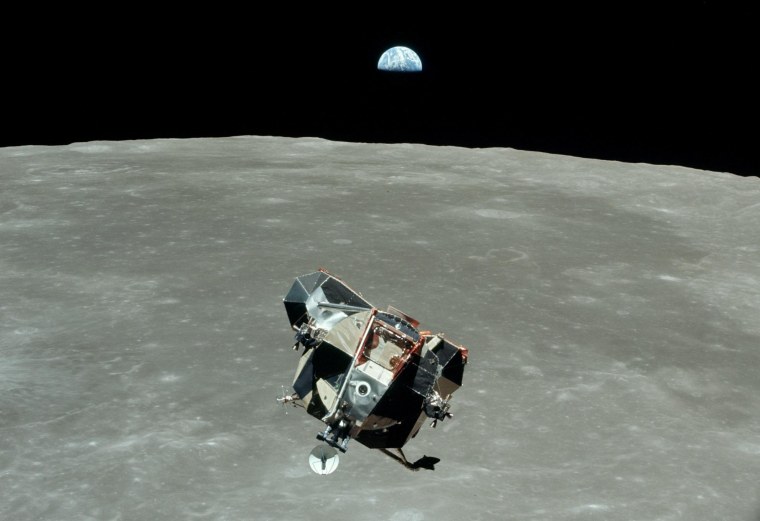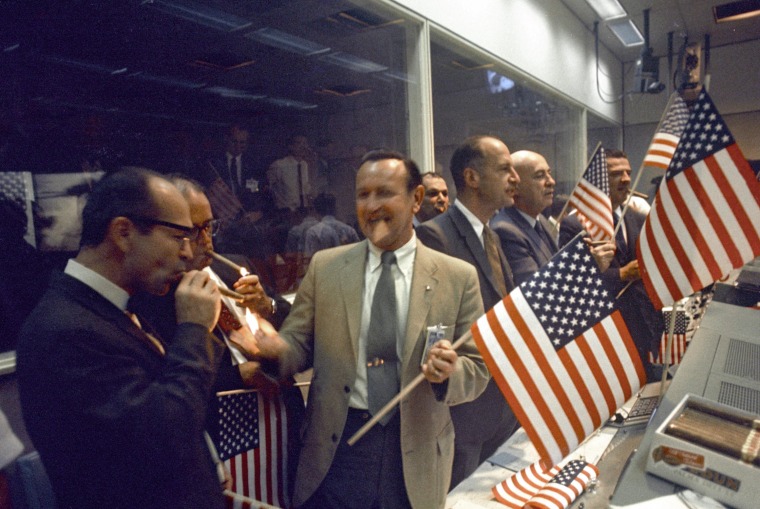He was absolutely still, his weight next to nothing — almost floating, and he resisted awakening from such comfort. But he was cold — too cold to sleep. He thought about it, resting there in that wonderful semiconsciousness of half-sleep and half-awake.
He refused to open his eyes. He would just shiver and listen to the sounds that were trickling, whispering, humming along soft but persistent — an endless mechanical and electronic brook.
But ignoring it did not answer the question. Where the hell was he?
NBC News' Jay Barbree, author of 'Neil Armstrong: A Life of Flight,' provides a day-by-day account of Apollo 11.
Neil Armstrong slowly opened his eyes and could gradually see his surroundings. He focused on the source of the bubbling brook's sounds — glowing circles, numbers, letters, buttons — and saw Buzz Aldrin standing at his window looking out at ... at what?
The moon, Armstrong scolded himself. You're on the moon. You were walking on it just hours ago ...
"How was it sleeping on the moon, Neil?" Mission Control interrupted his waking thoughts.
"Cold," he spoke quietly, nodding for Buzz to answer for them.
"Cold," Buzz told CapCom.
They had not anticipated when they put the window shades in place and turned many of Eagle's systems off to sleep, that they were turning off their source of heat. But despite the shivering, Neil had managed a couple of hours. Buzz told Mission Control, "Neil rigged himself a really good hammock with a waste tether and made him a bed on the ascent engine cover. He’s just waking up."
"Great," Mission Control responded. "Tell 'im he has some flying to do."
One-by-one they moved through the countdown, and when they had only 10 minutes to go, Neil and Buzz stood side by side before Eagle's controls. They were set for the first launch from another place in the solar system.
Mike Collins called from their command ship Columbia: "Neil, I’m reading you on VHF. You sound good."
"Yes, sir," Neil answered. "Couldn’t be better, we're just purring along."

Everyone knew that if everything worked as planned, the astronauts were just along for the ride. At 5 days, 4 hours, 4 minutes, and 51 seconds elapsed time in their historic mission, capsule communicator Ron Evans cleared Neil and Buzz for launch from the moon's Sea of Tranquility.
Forty-five years ago today, Eagle blasted free of its bottom-half launch platform. Neil watched as transparent flames from the ascent rocket ripped into the moon. Gold foil tore away from the landing stage, showering bits and pieces outward in all directions, and he saw the American flag they'd labored to raise whipped back and forth by their ascent engines' thrust — until it toppled to rest in lunar soil.
Eagle's ascent rocket burned perfectly. For nearly two trips around the moon, Eagle chased Columbia. The two moonwalkers caught their ride home as planned. All three astronauts were full of laughter and happiness, and Neil and Buzz transferred their lunar booty into the command ship. Then, when it came time to fire Apollo 11's big service propulsion system to head home, it all went by the book.
Three days later they were riding three beautiful main parachutes down to a safe landing on the Pacific. They had fulfilled President John Kennedy’s call to land on the moon before the decade was out, and return safely to the Earth. But even more important, they had proven we could visit a place beyond our home planet. That's a know-how humans must develop fully if we are to survive.

IN-DEPTH
- Part 1: How Neil Armstrong Got Ready for the Moon
- Part 2: Memories of Apollo 11's Launch Burn Brightly
- Part 3: Lighter Moments Between Earth and the Moon
- Part 4: Apollo 11's Crew Feels the Pull of the Moon
- Part 5: Minutes of Suspense as Apollo 11 Rounds the Moon
- Part 6: How Neil Armstrong Saved the Day on the Moon
- Part 7: 'Giant Leap' Had Deep Meaning for Neil Armstrong
- Read an Excerpt from 'Neil Armstrong: A Life of Flight'
Sign up for Science news delivered to your inbox.
This is the last installment of an eight-part series retracing the Apollo 11 mission to the moon, day by day. The account is based on material from Jay Barbree's New York Times best seller, "Neil Armstrong: A Life of Flight."
Barbree will discuss the Apollo legacy on "Virtually Speaking Science," an hourlong talk show that airs on Blog Talk Radio and in the Exploratorium's Second Life virtual auditorium. The show airs Monday at 8 p.m. ET.